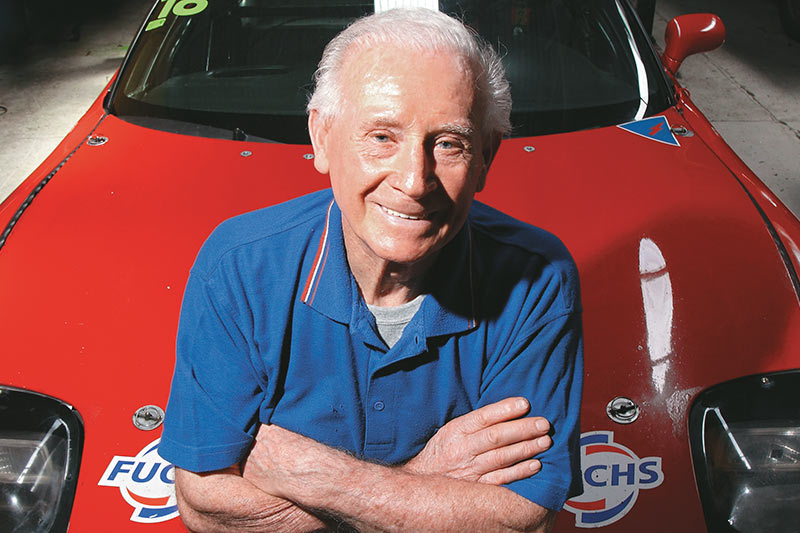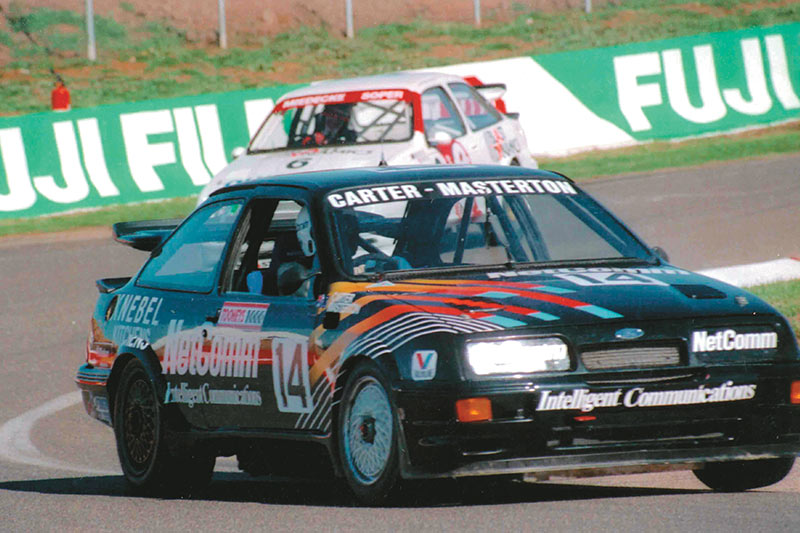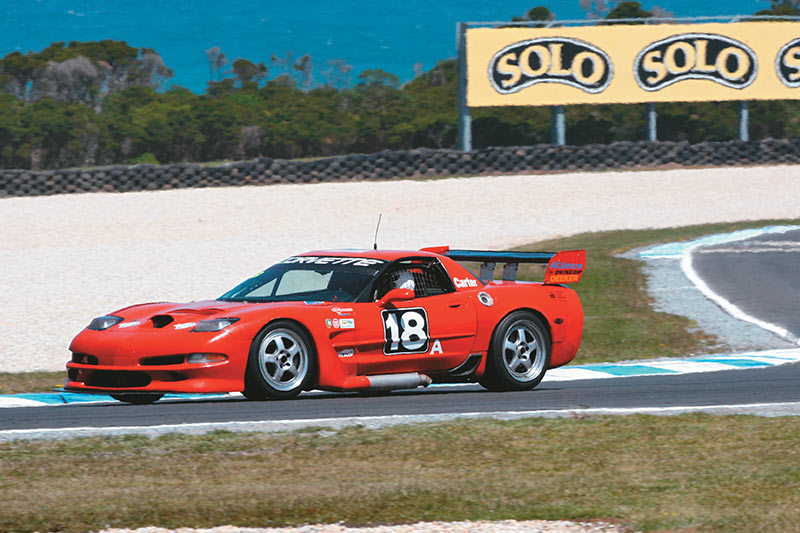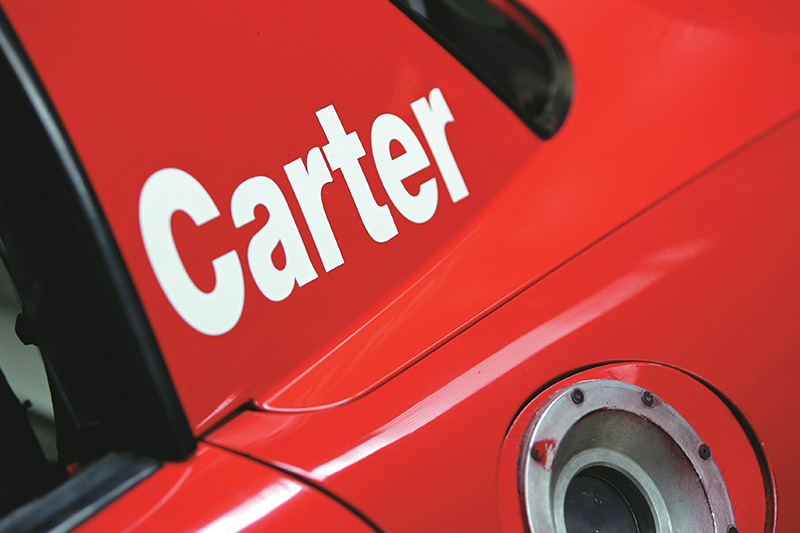Feature: Racing Legend Murray Carter - The Classic Privateer

















|

|

|

|

|

|

|

|
With decades of motorsport under his wheel rims, Murray Carter proves it's spirit and not age which truly matters
From the archives: Looking back on our chat with Murray Carter, as first published in Unique Cars #295 from Feb/Mar, 2009
If Murray Carter had been in movies he could have been Australia’s answer to the late Paul Newman. Because, like Newman did, this grand old man of Australian racing is still punching out hot laps in his seventies, in a 500 horsepower Corvette, no less. Amazing.
A spritely, compact man with shining blue eyes, Carter turned 78 in January and has no plans to retire anytime soon. His hearing is a bit shot and his memory a bit hazy when it comes to names and dates, but he just loves to talk about racing and not just the past.
Best known for his touring car exploits from the 1970s onwards – he was runner up to Colin Bond in the ATCC in 1975, his best result – Carter was the classic privateer and rarely contested every round of the championship, but he was loved by Ford fans in particular.
When Unique Cars visited Carter at his workshop opposite Melbourne’s Southland shopping centre (he bought the land in the ’60s!), he was preparing to go to the US to buy the latest Corvette quick bits at the Performance Racing Industry show in Miami. That’s how much racing means to Murray.

Carter was born in 1931, into a family without a car and to a father who had no interest in automobiles. A staid bank worker, Carter’s dad could never understand his teenage son’s fascination with cars and motorcycles. "Dad used to say, ‘There’s something wrong with that boy,’" Carter laughs, adding that having a job in a bank was viewed as successful back then. "I was more interested in mechanical things. I built my first motorbike, a Triumph Tiger 100 with twin megaphone exhausts. I used to practise up and down the street, and the woman up the road used to say, ‘We’re all going to be happy when you kill yourself’."
Young Carter devoured every book and magazine about racing that he could get and dreamed of competing in classics like the Le Mans 24-Hours and Mille Miglia. Racing, he says, just seemed like a natural thing to do. But it was expensive and times were tough in the post-war years. Although Carter never did a mechanic’s apprenticeship (his first job was building ‘wireless’ radios) he had a natural aptitude for mechanical work and was a panel beater by trade, a skill that would come in very handy. He started racing his Triumph in 1948 on the runways of the Commonwealth Aircraft Factory’s airfield in Port Melbourne, commonly known as Fishermens Bend, due to its location.
"It just had two long straights and you just went up and back; there were no sweepers or anything like that," he shrugs. "You needed horsepower and brakes. Motorbike racing was very popular and it must have been cheap because you could buy a new bike for £260 and I was earning £20 a week."

Carter graduated to a Jaguar XK120 in 1953-54. It had been raced at Goodwood and Silverstone in England prior to being imported by Bib Stillwell. "I paid £1000 for it, spent another 1000 turning it into a race car, then sold it for £1000. I put centre-lock wire wheels on it and the cams out of Lex Davison’s HWM-Jaguar."
There was hardly a motorsport industry in Australia in the lean ’50s and only wealthy racers like Stan Jones, Lex Davison and Bib Stillwell had the quid to import the latest European cars. The rest had to build their own specials from whatever they could buy or scrounge. Carter became a master at constructing cars from a jigsaw of foreign parts, and his first racer became legendary but almost killed him.
The famous Carter Special was a hand-made open-wheeler that was quick in spite of Carter’s lack of engineering credentials. What he lacked in qualifications, Carter made up for with nous, like how he arrived at the suspension layout for his bitsa.
"Len Lukey had just got a new Cooper-Climax and I asked him if I could measure his wishbones and his steering geometry and I basically copied it; I wanted to build something that I knew worked," he winks.

The Carter Special was originally meant to be rear-engined but Carter could not find a suitable transmission. It had a steel spaceframe chassis with Holden wishbones, a cut ’n’ shut Holden crossmember, Renault steering rack, 100S Austin Healy diff with in-board drums and Humber discs and calipers. It was originally powered by a Repco-Holden six but Carter got hold of a 283 cubic inch Corvette engine and gearbox and it was light, compact, well balanced and had plenty of grunt. "A lot of people said the car was built before its time," he says proudly.
Carter first raced the Special at Fishermens Bend in 1959 and it was a very successful car, coming fourth in the Gold Star at Phillip Island behind a pack of factory Cooper-Climaxes. But he also had a very close call in it at Phillip Island. "I was racing Bib Stillwell and we touched wheels in turn four and my car was launched into the air, rolled a few times and was wrecked. I was thrown out and knocked unconscious but I was back at the track the next day. Bib said later that he (Bib) shouldn’t have been ‘pussy-footing around’. I thought, ‘I’m out of my league, I’ll rebuild it as a sports car’." What was left of the Special was reborn as the Carter Corvette.

"Totally different", this car was conceived as a sportscar with a bespoke chassis that took Carter six months to build by himself. Again, he had no knowledge of aerodynamics but pursued his light and compact mantra. The Carter Corvette debuted in 1960 and became one of the most successful sportscars of the era, regularly beating more fancied Maseratis and E-Type Jags, with Carter setting many lap records.
"We made the aluminium body and it had just enough bodywork to meet sportscar regulations," he says, the Gold Star at Phillip Island behind a pack of factory Cooper-Climaxes. But he also had a very close call in it at Phillip Island. "I was racing Bib Stillwell and we touched wheels in turn four and my car was launched into the air, rolled a few times and was wrecked. I was thrown out and knocked unconscious but I was back at the track the next day. Bib said later that he (Bib) shouldn’t have been ‘pussy-footing around’. I thought, ‘I’m out of my league, I’ll rebuild it as a sports car’." What was left of the Special was reborn as the Carter Corvette.
"Totally different", this car was conceived as a sportscar with a bespoke chassis that took Carter six months to build by himself. Again, he had no knowledge of aerodynamics but pursued his light and compact mantra. The Carter Corvette debuted in 1960 and became one of the most successful sportscars of the era, regularly beating more fancied Maseratis and E-Type Jags, with Carter setting many lap records.

"We made the aluminium body and it had just enough bodywork to meet sportscar regulations," he says, mischieviously. "After that I put a roof on it and turned it into Gran Turismo car so I could race in a different class. It was the first car I raced at Bathurst and I built a new 327 engine with high-compression pistons, but it blew the crankshaft right out of the block in the race."
But the Corvette eventually became uncompetitive against a new wave of imported Ferraris, Aston Martins, Coopers and lightweight Jaguars and Carter swapped it for a Jaguar XK150 and concentrated on building up his Cheltenham, Victoria, business for a few years.
Carter’s fame was really cemented when he became a touring car driver, and his tin top career spanned almost 30 years, starting with Falcon GTHOs and ending with Ford Sierras. His first taste of modern touring car racing came at the 1970 Sandown Three-Hour, where he raced an XW GTHO for Bob Rollington Ford. He prepared two cars but both DNF’d. He practiced at Bathurst that year but his team’s entry was too late and Carter didn’t race. But his whistle was more than whetted and he bought his own Phase II GTHO and finished 11th at Bathurst one year later. He was now hooked on touring cars although he doesn’t exactly look back on that era with rose-coloured glasses.

"We had to run the HOs as production cars," he recalls. "They had plenty of straight-line speed, but didn’t have the brakes to suit their performance; if they did they would have completely demoralised the opposition. They only had a roll hoop for safety but (Ford Motorsport boss, the late) Howard Marsden had a clever seat cover made that held you in place a bit better. When we raced in those days I had one full-time guy and mates who’d give me a hand. I used to work all night because I still had to run the business. It was pretty demanding to fund it, work on the car then take it to races. If it was today I wouldn’t do it."
Carter’s best result at Bathurst was third in 1978 in his XC Falcon coupe with Graeme Lawrence co-driving. Although well connected to Broadmeadows, he was never an official Ford factory driver, but that didn’t, er, phase him! He says he liked being an independent, which is why he had no qualms about going to the Dark Side and racing Japanese cars, namely Nissan Skylines and a Mazda RX-7.
"The RX-7 was great, it was a new concept for me. It had less power but it was light and it’s the quickest car I’ve ever been around Bathurst in. Then I got a Skyline DR30, which was a great little car too but the production intercooler couldn’t control the heat at the boost we wanted to run. When Nissan moved on to the Godzillas, Nissan Japan said they’d sell me one but I couldn’t afford it, so I got a Sierra."
The Sierra was the last car Carter raced in the Australian Touring Car Championship. The constant drain on finances needed to remain competitive finally wore him down and, at 61, he quit the series.
"If you had a bottomless wallet, Sierras were great but I’d never have another turbocharged car… we used to split blocks, blow head gaskets and detonate engines. It was always obsolete, they always had something better in England and I was constantly on the phone trying to keep up and it got to the stage where I was losing interest."

Carter moved to Production Car racing, which was cheap but still competitive and he was quite successful in a Nissan Pulsar SSS, winning his class in the 1993 Bathurst 12-Hour. But you could never keep Carter away from his beloved V8s and the introduction of the Nations Cup sportscar series gave him a chance to get serious again. And again he turned to a Corvette, buying a 373kW, 6.0-litre C5 in 2000. But it had its troubles.
"We had to run it in production spec and it kept blowing engines. When Nations Cup folded, Marque Sports Car Racing asked me to join and they let me do what I needed to make the Corvette competitive and reliable; they didn’t want another Porsche!"
Carter built more reliable engines and fitted giant Harrop brakes and an air-shifted Holinger sequential gearbox, but he wants more. "I’m interested in GM’s new supercharged 6.2-litre LS9. It makes 620hp (462kW) but I’d run it without a supercharger so I can keep the weight down."
Carter has never officially retired from racing and don’t expect an announcement soon. "I’m pleased that I still enjoy it as much as I did in the early days," he says, smiling.
And, if it’s not too impertinent to ask, how well do you reckon you drive these days, Murray? "I still drive as well as I could have done in my early days," he quips. "I constantly drive to the capability of the car, I don’t want to find the point of no return."
Snapshot
Name: Murray Carter
Born: January 30, 1931
Claim to fame: Still racing at 78
Career highlight: Second in 1975 ATCC
Career lowlight: Buying a Sierra RS500
Inspiration: The never ending search for more speed
Favourite quote: Never go past the point of no return
Unique Cars magazine Value Guides
Sell your car for free right here
Get your monthly fix of news, reviews and stories on the greatest cars and minds in the automotive world.
Subscribe

.jpg)













